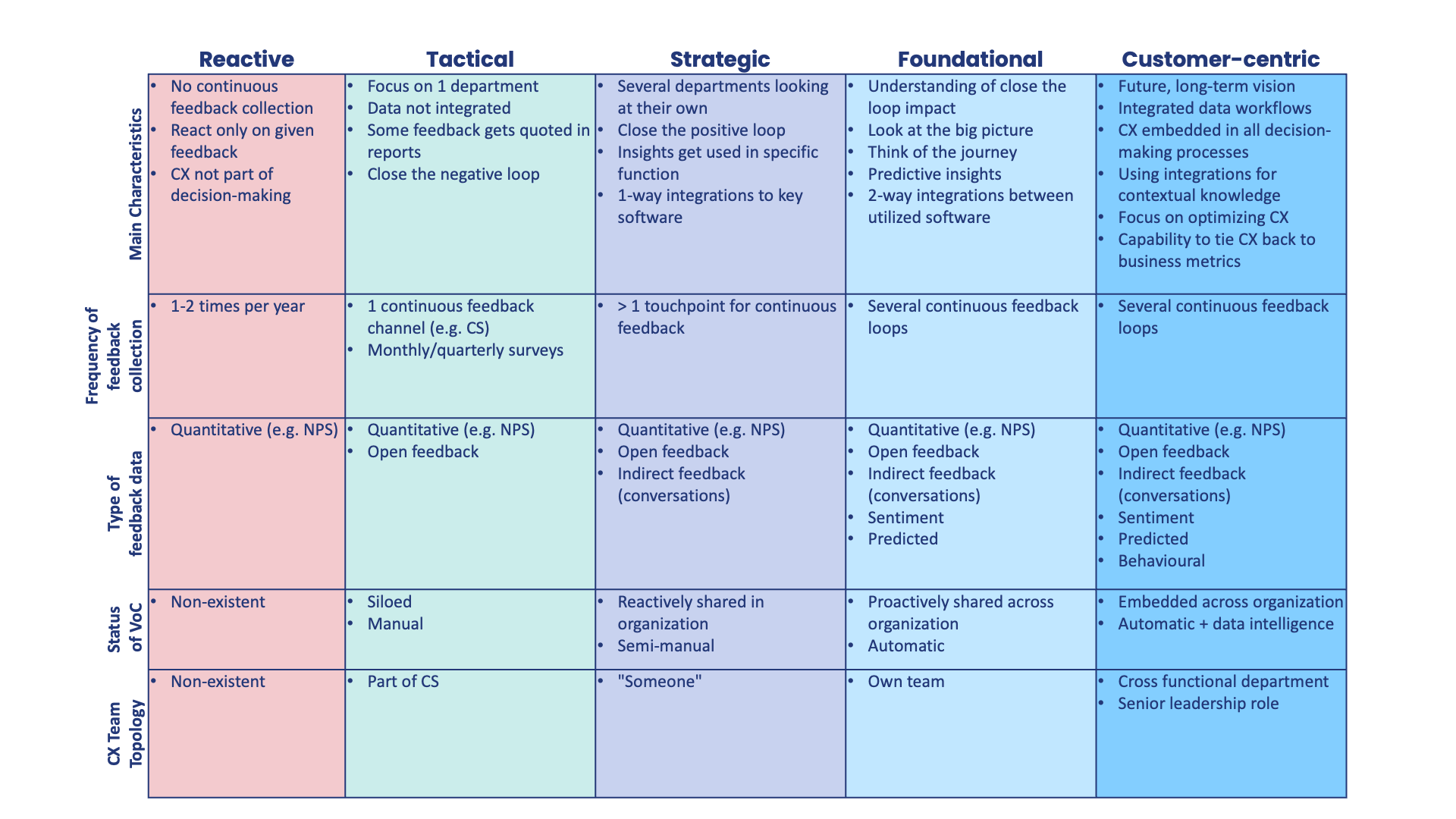In an era where consumer expectations are at an all-time high, the question isn’t whether delivering exceptional customer experiences (CX) is essential. It’s how your organization can master this to stand out in today’s competitive landscape.
But what does the path to genuine customer-centricity look like? And is reaching the ultimate level of customer focus the right goal for every company?
We created a CX Maturity Matrix to serve as a roadmap, outlining five distinct levels of maturity that companies meet on their CX journey. By honestly evaluating where your organization currently stands, you can set realistic goals for continuous improvement. However, achieving higher levels of CX maturity demands more than just adopting the latest tools or technologies. It requires a shift in mindset and a longer-term commitment to customer-centricity. And it should align with every aspect of your business strategy and operations.
The five levels of the CX Maturity Matrix:
- Reactive: Customer interactions are ad-hoc and transactional. Feedback is infrequent and rarely utilized for improvements. VoC efforts are non-existent or manual with no clear ownership.
- Tactical: Basic CX practices like collecting feedback exist but are siloed within departments. Efforts to address issues are tactical versus strategic. VoC is owned by a single team.
- Strategic: Multiple departments align on CX, using insights to improve specific functions. Continuous feedback captures quantitative and qualitative data. VoC insights are reactively shared across the organization.
- Foundational: A holistic view guides CX initiatives through the customer journey. Predictive capabilities emerge from integrated feedback systems capturing multi-dimensional data. Dedicated CX teams systematically operationalize insights.
- Customer-centric: CX is a core strategic driver across the organization. Deeply embedded customer insights from integrated data to optimize individualized experiences. Cross-functional roles ensure end-to-end accountability.

The Non-Linear Path of CX Transformation
While this CX Maturity Matrix provides a useful framework, it’s important to recognize that the journey is not always linear. As an organization’s business strategy shifts, it may need to move between maturity stages to realign its customer experience approach. Goals and priorities can change, requiring flexibility to adapt CX efforts accordingly. In both directions.
Achieving the “Customer-centric” level is not and should not be the ultimate goal for every company
Furthermore, achieving the “Customer-centric” level is not and should not be the ultimate goal for every company. This level of maturity demands significant investments in resources, technology, and cultural transformation. Organizations must carefully evaluate if such comprehensive customer-centricity aligns with their overall strategy and is viable for their specific context.
The Core Challenge: Cultural Shift Towards Customer-Centricity
Regardless of the desired maturity level, the biggest challenge doesn’t lie in implementing tools or policies. It lies in fostering a cultural shift toward customer-centricity. Tools and technology can act as a catalyst, but not the sole driver.
This transformation requires commitment from senior leadership to embed CX principles into the organization’s DNA. It’s a continuous journey of empowering employees, breaking down silos, and ensuring customer insights are consistently used for decision-making across functions.
Attempting to take shortcuts will likely undermine the entire effort. Achieving true CX excellence takes time, grit, and a willingness to adapt strategies as needed. Lasting changes demand a realignment of culture, processes, and mindsets throughout the company.
Conclusion: Embracing the CX Journey
Understanding your current level of CX Maturity and where you aspire to be is just the start. Setting achievable goals, and embracing the tough yet fulfilling journey of strategic change and cultural shift is key for companies. This way, they can create their unique route to providing top-notch customer experiences. Successful companies will build strong relationships with their customers. They will not only meet but also surpass expectations, leading to lasting success.
Did you like the post?
You might also like:

Surveypal
Everything you need to lead and improve your customer experience. Learn more at surveypal.com, or







